SIMPLE TWISTS OF FATE: Symphony couple finds niche in the heartland
Fortune smiled on Kansas City music lovers when Tamamo Someya and Mark Gibbs decided to marry and settle down here. Born in Japan just a few years apart, they traveled very different musical roads before converging, finally, at the Kansas City Symphony: Tamamo as principal second violin, Mark as principal cello. Curiously, at a couple of crossroads on this path, they came tantalizingly close to meeting.
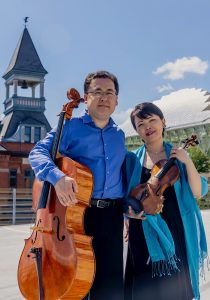
Tamamo Someya (Gibbs) received her training entirely in Japan, starting at age three with classes in Suzuki method and continuing at the Tokyo College of Music Prep School and Toho High School. At Toho Gakuen College of Music she was a pupil of Kenji Kobayashi, a former student of Shinichi Suzuki himself and, at the Juilliard School, of legendary violinist Ivan Galamian.
Mark was born in Japan but from age four through 17, he lived mostly in Berkeley, California, with his Japanese-born mother and American father, the latter a (now-retired) professor of history. Later, at Northwestern University’s Bienen School of Music, Mark trained with cellist Hans Jørgen Jensen: a string guru whose pupils now populate orchestras worldwide.
The Gibbs union happened as the Kansas City Symphony was beginning its ascendancy. And despite the lure of larger orchestras through the years, this musical power couple has learned that a happy marriage, two wonderful daughters, an emerging orchestra performing in a world-class hall, and a community that supports it with vigor, are enough to make Kansas City the right place to be.
“Some couples are lucky enough to get into the same orchestra,” said Mark, who joined the Symphony in 1999 and holds the Robert A. Kipp Chair. “But that is very, very, rare.”
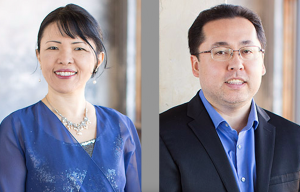
When Tamamo landed the principal second violin position, also in 1999, neither suspected that this might clear a path for establishing a personal and musical equilibrium.
Japan’s musical community is, like Kansas City’s, a “small world.” Several years into their tenure here, the couple discovered that Symphony First Violinist Tomoko Iguchi, a longtime friend of Tamamo’s in Tokyo, was the niece of a woman with whom Mark’s mother, a nurse, once worked. “I used to commute to swimming lessons with her daughter, Tomoko’s cousin, when we were kids,” Mark said. (He is still an enthusiastic swimmer.)
Although the two never met at the time, years later it was Tomoko who encouraged Tamamo to audition at Kansas City. After stints with the New World and Sacramento Symphonies, Tamamo had intended to return to her professional orchestra in Tokyo. But she won a job here and moved to Kansas City in 1996. When Mark joined the Symphony, first as section cellist and shortly afterward as principal, fate had finally brought them together.
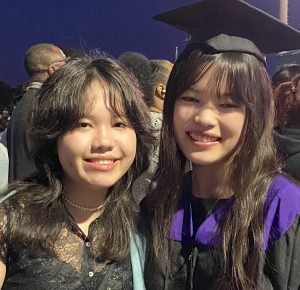
Artistically, too, the couple found there are relatively few “degrees of separation” in the string world. Leonard Rose, the formidable cellist who was one of Hans’ teachers at Juilliard, was a great admirer of Ivan Galamian’s teaching and practicing methods, which he absorbed, adapted for cello, and passed onto his students.
Hans would later formalize these methods and publish them as CelloMind, ViolinMind, PraticeMind, and other widely used publications. Thus in a sense Mark and Tamamo are both descended from a common artistic lineage that includes many of today’s leading string artists: from Pinchas Zukerman to Lynn Harrell, Itzhak Perlman to Yo-Yo Ma.
Meadowmount School would also play host to a crucial moment in Tamamo’s and Mark’s relationship. In 2003, a year before they decided to get married, the couple traveled to the summer program in Upstate New York together, enhancing their growing feelings for each other with a sense of musical unity as expressed in the school’s teachings and artistic philosophy.
When Mark introduced Tamamo to Ivan Galamian’s 96-year-old widow, Judith Johnson, they were delighted when she asked: “So how is Kenji?” Judith still fondly remembered Tamamo’s old teacher, Kenji Kobayashi, who had been a beloved pupil of her husband. “That felt like a full-circle moment of sorts,” Mark said.

It is not surprising that many symphony orchestras contain several married couples. Orchestras consist of like-minded artists whose love of music transcends nearly all other differences. For Tamamo and Mark it was a sort of slow burn: Initially they admired each other more for artistic reasons than romantic ones.
“We were just colleagues and friends before we got closer,” Tamamo said. “It was all very natural.” One significant early encounter was when they each played back-to-back recitals on the Midwest Trust Center’s Ruel Joyce Series. “He turned pages for my pianist, and I turned pages for his pianist,” Tamamo said. “We were not playing together, but our recitals happened to be a week apart.” She was impressed at the care with which Mark approached the music: “I saw him preparing, I saw his devotion.”
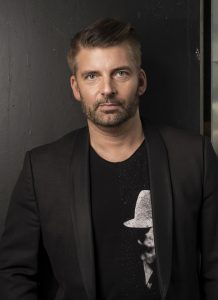
Subsequently they began practicing together, raiding adjacent practice rooms in the UMKC Conservatory basement and forming an artistic bond that few non-musicians can comprehend.
When Tamamo’s father visited here and first met Mark “he said to himself, oh it would nice if someone like that married my daughter,” Tamamo recounted, adding with a smile: “He kept it to himself until after we got married.”
Mark liked everything about Tamamo: “Her openness, her kindness, her generosity. … I’m naturally attracted to popular people, and everybody loves Tamamo.”
Tamamo found Mark “musically inspiring. … I feel so lucky that I can respect him as a colleague, cellist, and musician. He made me feel confident as a person.” On the latter point, Mark countered: “I don’t know if I can lay claim to that. I mean, it takes quite a bit of chutzpah to depart your native land and say okay, I’m going to try America.”
To be sure, orchestras in the United States do offer musicians something remarkable. “The greatest thing about the American musical scene is the nature of the blind auditions,” Mark said. “That’s how we’re able to attract the best and brightest, and it’s totally objective.”
Outside of the responsibilities of serving as Symphony principals during a time of rapid change, Tamamo and Mark are exceptionally proud of their gifted daughters. Mika is a violin student of Kathleen Winkler at Rice University’s Shepherd School of Music and this summer will attend the Aspen Music Festival and School on a fellowship.
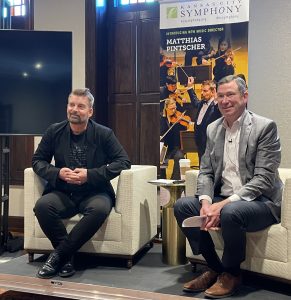
Maho, an honor’s student at Blue Valley Northwest, recently won the Martin Luther King Jr. Legacy Scholarship from the Johnson County NAACP chapter and is slated to attend this year’s Simons-New York University Science Explorations Program. She was also just accepted into the Civic Innovation Academy by Civics Unplugged, hosted by UCLA this summer. Each began playing at age five, quite eagerly, and both have grown into extraordinarily talented violinists.
Meanwhile, their parents are gearing up for the ride of a lifetime, as the Symphony introduces its newly appointed music director, Matthias Pintscher. The intimacy of the German-born conductor’s connection with the players has been palpable in his initial appearances with the orchestra.
“What makes musicians compatible with one another is a sense of consideration and openness, of listening,” Mark said. “When you converse with someone, you’re supposed to listen before you speak. … You then bring what you have and wait for the other person to bring what they have.
“And that has always been the case with Matthias … Then there’s always a space between the two, and what we want to do is fill that space. He has an ear for that, a sense of timing, of planning: of timing in the moment but also over the course of days, weeks, and hopefully years.”
— By Paul Horsley




